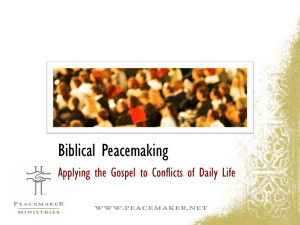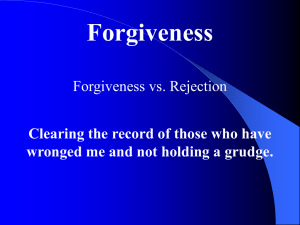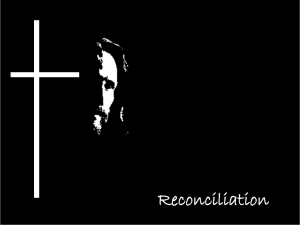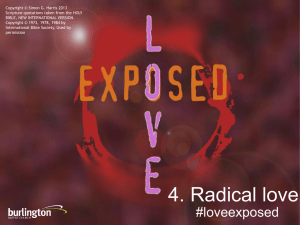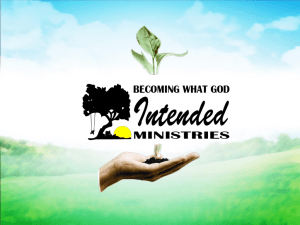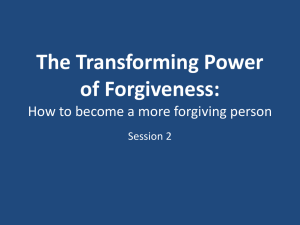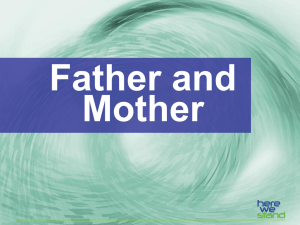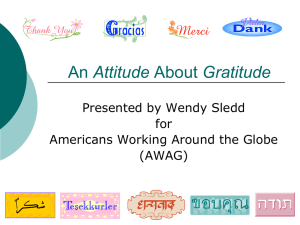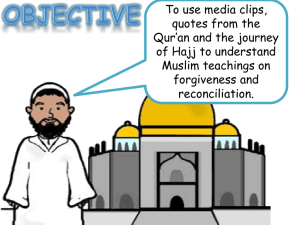File
advertisement
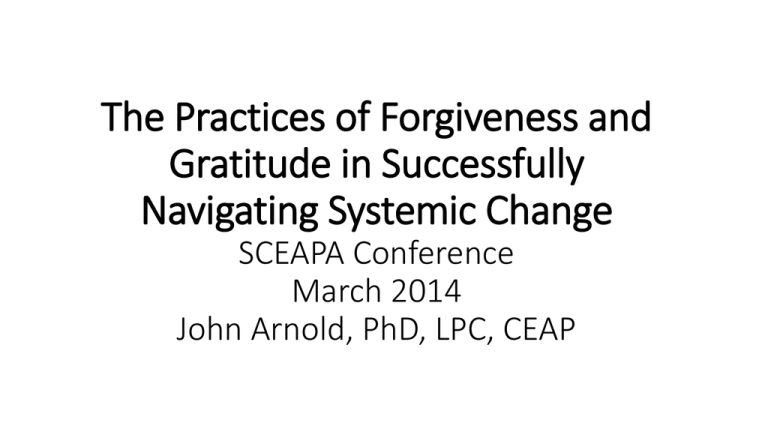
The Practices of Forgiveness and Gratitude in Successfully Navigating Systemic Change SCEAPA Conference March 2014 John Arnold, PhD, LPC, CEAP Premise The psychologist Alfred Adler endorsed the task of occupation as one of the three significant life tasks all human beings must address. With rapid change driven by multiple variables, the contemporary workplace continues to be a volatile context in which it is difficult to achieve contribution and satisfaction. Two emotional outcomes of this are resentment and hurt / victimization. To assist discouraged employees and workplace systems, employee assistance professionals and affiliates should be ready to address issues of forgiveness and gratitude. “We must be willing to let go of the life we planned so as to have the life that is waiting for us.” Joseph Campbell Forgiveness and Gratitude-An Interface with: A.) Positive Psychology B.) Positive Organizational Citizenship Positive Psychology • In modern times, date back to psychologist William James (died 1910) • Influenced by Abraham Maslow’s theory of human selfactualization. (1943) • 1964, Virginia Satir (family therapist) encouraged the field of psychology not to be singularly oriented to human pathology. • 1998, Dr. Martin Seligman picks Positive Psychology as the theme for his term as president of the American Psychological Association. Positive Psychology Positive Psychology is interested in “optimal human functioning.” It focuses on… •Client strengths and assets •Human resiliency and health •What is “right” with people in contrast with what is “wrong”, dysfunctional. (A “positive” DSM-5) Positive Psychology is interested in •Happiness / The Good Life •Effectual growth and change •Human “flourishing” •Qualities of resilience •Human values and virtues… including forgiveness and gratitude. (amongst many other things) Positive Organizational Citizenship Defined by Dennis Organ in 1988 (D. Katz in 1964) Individual (employee) behavior which is: a.) discretionary (not part of a job description; a personal choice) b.) not directly or explicitly recognized by the formal reward and compensations system. Any “reward” is indirect. c.) and, when done in aggregate (by many employees) results in the effective functioning of the workplace. The workplace is a better place. Positive Organizational Citizenship • Examples: courtesy, tact, “using your voice”, appreciation, politeness, gratitude, forgiveness, sportsmanship, supporting professional memberships connected to the organization. • Maintains the goodwill of any work-team and keeps the energy of the workplace positive and upbeat in ways which are difficult to qualify. Forgiveness: A Cultural Perspective… A long history in human culture and interaction… Greek: “aphiemi”: “to send away” Hebrew: “salach”: “to send away; to let go” (A requirement to accept.) Chinese: Buddhism: “metta”: “loving-kindness”. Release the desire to hurt back. Chinese: Confucian tradition: “ren”: benevolence, charity, love Arabic: “’afw”: to release, to heal, to restore. Islam promotes forgiveness as more virtuous than justice. Cheyenne: “navonetano ta”: “I have forgotten it.” A Native American tradition to live in harmony with nature and fellow human beings. How do you define “forgiveness”? Forgiveness “To forgive is to set a prisoner free… and discover that the prisoner was you.” (Lewis B. Smedes) Forgiveness Resentment is a pair of handcuffs. I make myself the slave to the person I resent. I make myself emotionally and psychologically handcuffed to them. Forgiveness, then, becomes the key. (Peter Bliss, 2011) Forgiveness Without forgiveness, resentment becomes toxic. Resentment is like trying to kill someone by taking the poison. Forgiveness Recent research suggests… • Forgiveness is an interpersonal skill that can be taught • Forgiveness plays correlates with resiliency in “down-sized” employees • Forgiveness decreases reports of depression • Forgiveness increases reports of serenity in terminally ill patients • Forgiveness correlates with positive outcomes in treatment of heart disease • Forgiveness correlates with measures of improved immune response Forgiveness The paradoxical quality of forgiveness. As I forgive someone who - doesn’t deserve it, - doesn’t know I’m doing it, and - doesn’t even want my forgiveness– Oddly, I am the one who benefits. I am the one who is healed. Forgiveness Some things Forgiveness is not: - It is not minimizing the act or the hurt - It is not excusing the hurt - It is not overlooking the hurtful behavior from a position of moral superiority / martyrdom - Forgiveness is not the same thing as “Reconciliation.” - Others? When is a client ready to consider Forgiveness? Stages of Change: • Pre-contemplation: the stage at which there is no intention to forgive in the foreseeable future. An employee in this stage may be unaware or minimizing the impact of resentment on their life. • Contemplation: the stage in which an employee is aware that the hurt is a problem. They begin toying with the idea but have not yet made a commitment to take action. • Preparation: starts to combine volition / intention and behavior. “What would forgiveness look like?” • Action: An employee experiments with modified behavior and modified “frame” about the hurtful event. The Action Stage involves public and overt behavior change; doing “something” different. It calls for intention and energy. • Maintenance: The employee works to prevent “relapse” back into hurt; declines invitations to feel “righteously angry.” Relapse may occur. New rituals are incorporated so as to reinforce progress and the new “frame.” Releasing the “Why?” of the event. “Okay, so how do I get there?” (Bliss, 2011) Recognize the a.) need to forgive and b.) the positive outcome in forgiveness Acknowledge the fact of the event (the “wrong”) and grieve it. “Ritually” cancel the “debt” because you choose to deem it “uncollectable.” Recognize and track the benefit that forgiveness brings to you Acknowledge that forgiveness is not “reconciliation”: there is nothing “they” have to do. Ritually cancelling the debt: The Forgiveness Letter. Forgiveness • Writing a “Forgiveness Letter” • For many clients, writing is a physical exercise which helps operationalize the hurt and to clear the mind. Writing can help organize information about the hurt that floats in fragments in our heads. Writing can foster the opportunity for “reframing”: to see the event from another perspective. Forgiveness Tips for Writing a Forgiveness Letter: • Keep it short and to the point. One sheet of paper • Write it out / don’t type • No need to rehash the event or the hurt • This is not a “rant”– this is about forgiving and letting go. • Options to read it to clinician, to burn, to tear up, to “void”. Generally, not written to be sent. Gratitude “As we tend toward gratitude, we connect with fellow human beings more readily. We are more apt to approach others in a “horizontal manner” (contribution / cooperation) rather than a “vertical manner” (competition / one-up).” “When we cultivate a grateful attitude, we develop a capacity for satisfaction and contentment. And gratitude builds bridges to others.” Richard Watts, PhD. President of the North American Society for Adlerian Psychology. Gratitude Gratitude is a “career skill” that the workplace and employees need to cultivate along with skills such as conflict resolution, good communication, co-operation, team-work, etc. Gratitude Benefits of the Practice of Gratitude: Physical: improved immune response, decreased BP, tend to exercise more, improved sleep. Psychological: Higher scores on scales of happiness and optimism, increased reports of “positive / pleasant” emotions. Social: Rated by others as helpful, generous, compassionate, forgiving, friendly. Decreased self-reports of loneliness / isolation. Workplace: Reports of higher energy to complete tasks; rated by team members as more cooperative. More resilient to negative stressors. How to cultivate Gratitude 1.) Keep a “Gratitude Journal.” Makes “counting blessings” more intentional. 2.) Study / keep company with “Grateful People.” 3.) Keep a “Gratitude Jar”. At the end of the day, all changes goes in the jar as a reminder to be grateful. Donate the funds when the jar is full. 4.) Write “Thank you” notes instead of texts or e-mails. 5.) When someone else thanks YOU, accept the thanks with grace. 6.) Want what you have. Whitbourne, Susan (2010). Giving Thanks: The Benefits of Gratitude. Emmons, Robert, PhD. (2007). Thanks! How Practicing Gratitude can Make you Happier. Emmons et al. Counting blessings versus burdens: An experimental investigation of gratitude and subjective well-being in daily life. Journal of Personality and Social Psychology, Feb. 2003. Grant et al. Gratitude and well-being: The benefits of appreciation. Psychiatry, Nov. 2010. Smith, J. 5 ways to Cultivate Gratitude at Work. 2013. Baker, Dan. What Happy People Know. Cheng, Cheri. Having a Purpose in Life is Healthier than Happiness. • International Forgiveness Institute: www.forgiveness-institute.org. University of Wisconsin. • John Templeton Foundation: www.templeton.org • Forgiveness: A Sampling of Research Results. APA, 2006 • The Journal of Positive Psychology • Emmons, Robert A. Gratitude Works!: A 21-Day Program for Creating Emotional Prosperity • Charles Derns, PhD. Gratitude at Work: Counting your blessings will benefit yourself and your organization. 2006.
